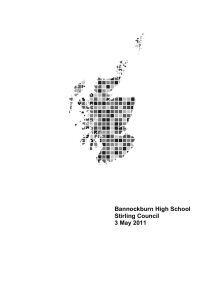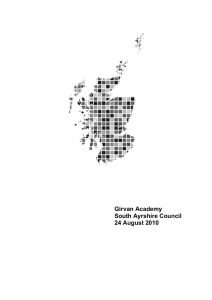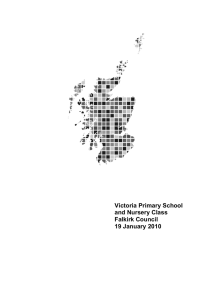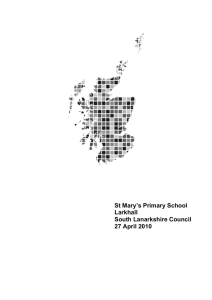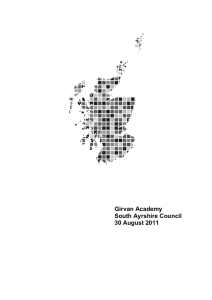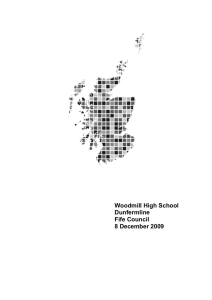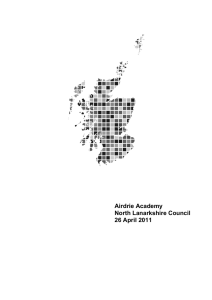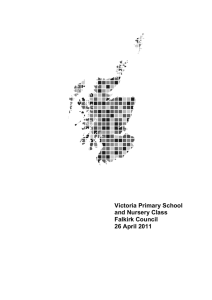Auchmuty High School Glenrothes Fife Council
advertisement
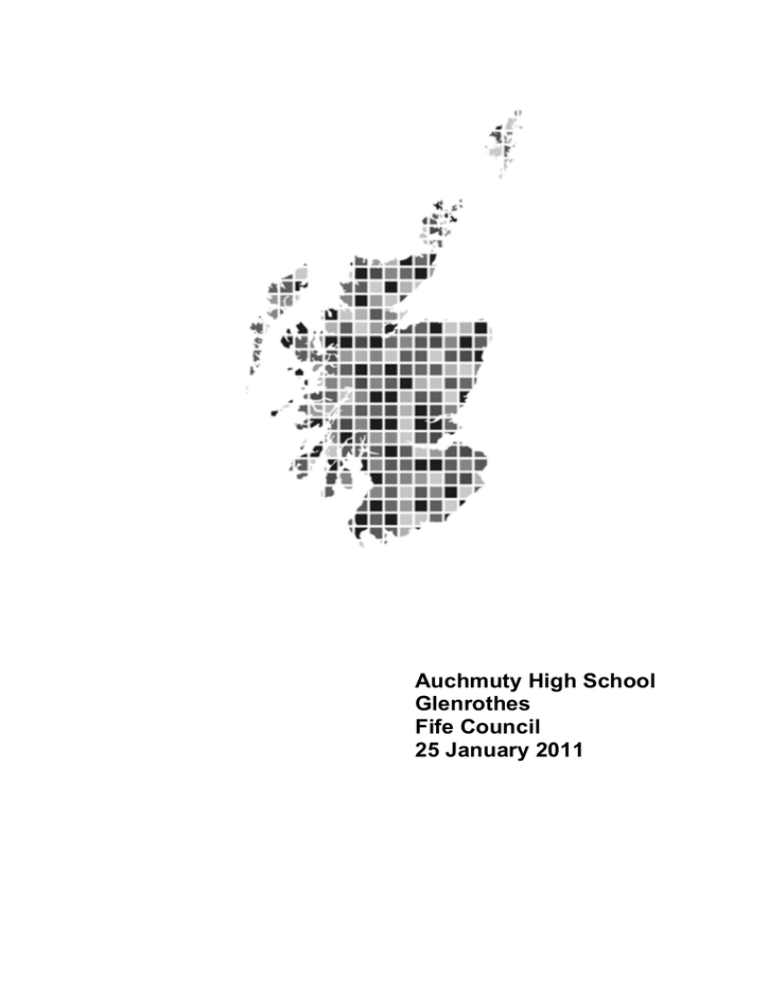
Auchmuty High School Glenrothes Fife Council 25 January 2011 We published a report on Auchmuty High School in June 2007. That report set out key strengths of the school and areas for improvement. We carried out follow-through inspections in April 2008 and March 2009 and published reports on those visits in July 2008 and June 2009. This follow-through report is based on an inspection visit which was carried out in November 2010. It tells you about improvements since the original inspection in the quality of education which the school provides. It also comments on how the school is getting on with the main points for action. First we focus on changes in the core work of the school. We explain how the school has got better at helping children to learn and benefit from being at the school. Next we look at the key processes which enable this to happen, including the involvement of parents1. Our report also describes developments in the ‘ethos’ of the school, by which we mean how well young people are cared for and how much is expected of them in all aspects of school life. Finally we comment on improvements in leadership to help the school achieve its aims. A copy of this report has been placed on the HMIE website www.hmie.gov.uk. Where applicable, you will also find analyses of questionnaire returns. 1 Throughout this report, the term ‘parents’ should be taken to include foster carers, residential care staff and carers who are relatives or friends. Contents 1. The school 2. Particular strengths of the school 3. How well do young people learn and achieve? 4. How well do staff work with others to support young people’s learning? 5. Are staff and young people actively involved in improving their school community? 6. Does the school have high expectations of all young people? 7. Does the school have a clear sense of direction? 8. What happens next? 1. The school Auchmuty High School serves the eastern side of Glenrothes and the surrounding villages. A new headteacher was appointed in June 2009. At the time of the follow-through inspection one of the depute headteachers was on a long-term absence. Since the last follow-through inspection there have been a number of new staffing appointments. Young people’s attendance is below national averages. 1 2. Particular strengths of the school • Improvements in the management of young people’s behaviour. • Staff who work together as a team and lead aspects of school improvement. • Improved leadership and direction of the management team and the new headteacher. 3. How well do young people learn and achieve? The quality of young people’s learning is now better. Staff now use better questioning to encourage young people to think more about their learning. Young people respond well when given opportunities to work cooperatively and take responsibility for aspects of their learning. These positive features need to be extended across the school. The school continues to offer a range of opportunities for young people to achieve. The newly-introduced house system provides a range of helpful contexts for young people to engage in friendly competition and house rivalry. The school needs to strengthen curricular links with associated primary schools and accelerate the pace of implementation in line with Curriculum for Excellence. At S1/S2, young people’s achievement in reading, writing and mathematics has improved. By the end of S4 and by the end of S6, attainment in most key measures is now better. Fewer young people are now excluded from school. More young people now stay on from S5 to S6. Levels of attainment by the end of S5 have not improved. At this stage, the school still performs less well than other schools which serve young people with similar needs and backgrounds. Young peoples’ attendance has fallen and is now below national averages. 2 Staff engage with community providers to develop more appropriate routes of progression which better meet young people’s needs. The school’s planning to meet young people’s additional support needs has improved. The house system has led to better links with learning support and the school liaison group. Staff have reviewed and improved further the school’s arrangements for managing behaviour, including the use of a new ‘Get, Set, Go,’ positive behaviour policy. 4. How well do staff work with others to support young people’s learning? Parents are now more involved when pupil support issues arise, enhancing the level of support available for young people. Staff work well with parents to improve attendance and punctuality of children who have difficulty with late-coming. The school needs to continue this work. Staff have developed further partnerships with other providers to meet the needs of vulnerable young people. 5. Are staff and young people actively involved in improving their school community? Senior managers have led well-revised approaches to observing learning, complemented by staff peer-to-peer observations in ‘learning rounds’. Increasingly, principal teachers use observation findings to identify strengths and areas for development within their departments. Staff are more fully consulted on matters pertinent to improving school. They value this very highly, feel more engaged and are motivated to improve their practice. More departments seek young people’s feedback on their learning experience, and make changes as a result. Staff now take greater account of ‘learner voice’ through committee work that has seen an increased role for senior pupils. There remains considerable scope to further develop ‘learner voice’ especially regarding learning and teaching. 3 6. Does the school have high expectations of all young people? Expectations of young people’s behaviour and attitude to learning have improved. The school has continued to encourage better behaviour from young people through an improved system of rewards and sanctions. All staff and almost all young people are positive that behaviour has improved overall. A small core of young people still need sustained support to manage and improve their behaviour. Young people’s confidence and aspirations of what they can achieve still need to be raised further. 7. Does the school have a clear sense of direction? Senior leaders now work more effectively together. They have developed more consistent approaches to linking with departments and managing behaviour. The extended management team approach has helped to improve the quality and consistency of departmental leadership. There is a much greater sense that almost all staff work together on a clear and agreed agenda for school improvement. Staff are committed to working towards further improvement. The headteacher, in leading and working with the senior management team, is ensuring a sustained focus on improving the quality of learning. 8. What happens next? The school now performs better. Overall attainment, staff’s expectations and the arrangements for self-evaluation are now at a satisfactory or better level. With the continued support of the education authority, the school has the capacity to improve further. We will make no further visits in connection with the inspection of February 2007. Our District Inspector will continue to engage with the education authority and the school to monitor the school’s progress. HM Inspector: Donald Macleod 25 January 2011 4 When we write reports, we use the following word scale so that our readers can see clearly what our judgments mean. excellent very good good means means means satisfactory weak unsatisfactory means means means outstanding, sector leading major strengths important strengths with some areas for improvement strengths just outweigh weaknesses important weaknesses major weaknesses If you would like to find out more about our inspections or get an electronic copy of this report, please go to www.hmie.gov.uk. Please contact us if you want to know how to get the report in a different format, for example, in a translation, or if you wish to comment about any aspect of our inspections. You can contact us at HMIEenquiries@hmie.gsi.gov.uk or write to us at BMCT, HM Inspectorate of Education, Denholm House, Almondvale Business Park, Almondvale Way, Livingston EH54 6GA. Text phone users can contact us on 01506 600 236. This is a service for deaf users. Please do not use this number for voice calls as the line will not connect you to a member of staff. You can find our complaints procedure on our website www.hmie.gov.uk or alternatively you can contact our Complaints Manager, at the address above or by telephoning 01506 600259. Crown Copyright 2011 HM Inspectorate of Education
